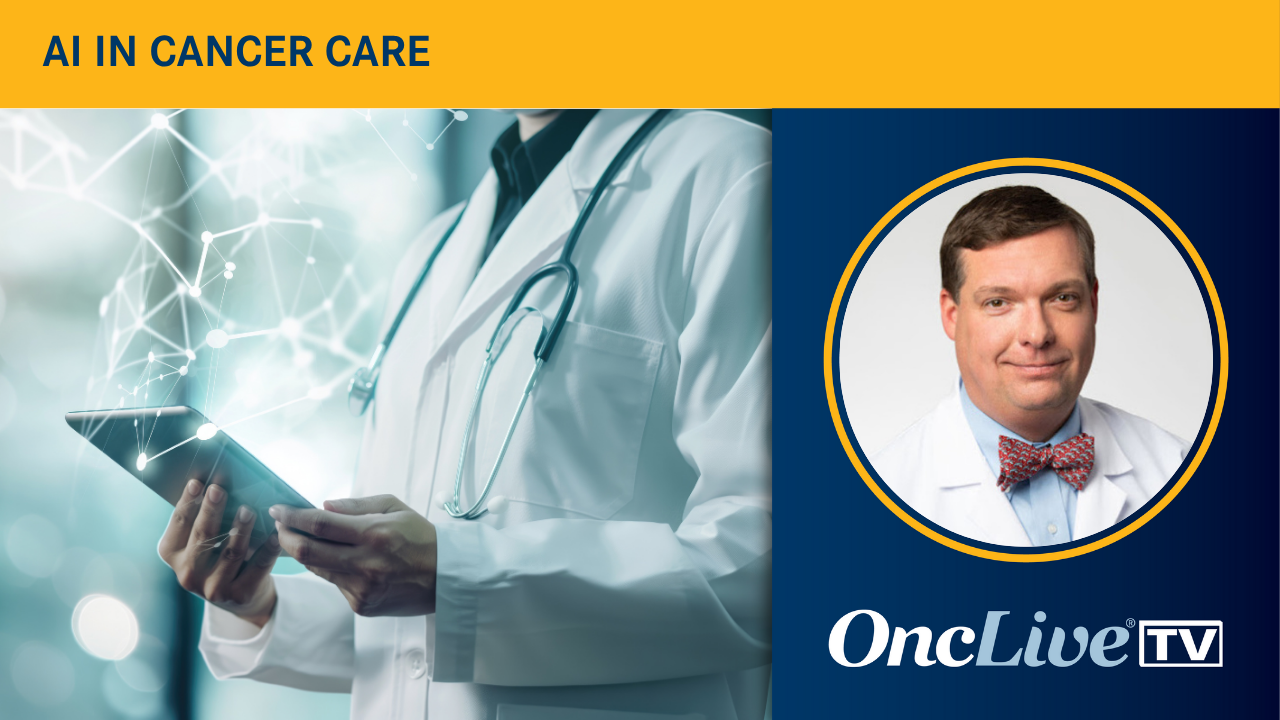Is AI Augmentation Driving Smarter, Better Cancer Care? | OncLive
Four experts share their perspectives on the potential challenges and future directions for AI integration in the field of oncology.
In the video above, Douglas Flora, MD, LSSBB, executive medical director of Oncology Services for the Yung Family Cancer Center at St. Elizabeth Cancer Center; Brian P. Mulherin, MD, an oncologist/hematologist at Hematology Oncology of Indiana, an affiliate of the American Oncology Network (AON); Jim Chen, MD, a board-certified physician at Genesis Cancer and Blood Institute (GCBI), a partner practice of AON; and Beau Hilton, MD, a medical oncologist at GCBI provided insights on the future roles for artificial intelligence (AI) tools and strategies in oncology practice.
Watch the video or read the transcript below to learn more about how AI may enhance the digitization and routing of health care information to streamline care coordination, the logistical and ethical challenges of integrating this technology into routine workflows, and the importance of educating oncologists on how to apply these tools effectively.
For a more in-depth look at up-and-coming advances with AI and their implications for real-world care,
[Transcript]
Flora: AI is going to help us ingest a greater amount of data, help us understand how to interpret that data better, faster, and then help us with clinical decision support so that we’re making the best possible decisions. With all of those data organized and accumulated for us, we’re not pulling out fax reports that are scanned into EPIC anymore. We have a formal document that’s prepared from unstructured data into a structured format that oncologists designed, and these tools exist today for us to be able to sit down with our patients, look them in the eye and say, ‘This is, in my belief, the best thing for you,’ based upon information I didn’t have 2 years ago, but is now readily available to [us] in the community.
Mulherin: It’s more a question of what role do we not see [for AI in oncology]. AI will not replace the physician. It is an augmentation to human intelligence and one that must be used thoughtfully and deliberately. But it could be used across the oncology spectrum, from scheduling software to AI optimization. Scheduling is fairly low-hanging fruit as far as AI is concerned. This ranges from ensuring that patients are getting appropriate testing and appropriate scans, to any number of other things [including] precision oncology.
Precision oncology ensures that you have the right patient, drug, and dose. That is one of the easiest use cases, but it’s also, in some ways, one of the least technically challenging. It should be fairly simple to figure out: Did the patient get next-generation sequencing [NGS]? Did they get on the appropriate drug or not? The dosing question is a little bit more complicated, because we don’t, as of right now, take into account pharmacogenomics. This has a role to play too.
I can see [AI] playing well everywhere. It’s not going to replace us. It’s not going to replace our nurses and our technical staff. It is an extension of human intelligence; it’s not supplanting it.
Chen: Integration of the technology is key. The nature of oncology care, and health care in general, is very fragmented, with a lot of systems that need to talk to each other. But let’s say we bypass those hurdles: the underlying problem is still that these tools are developed mainly by software developers, not necessarily by oncologists who may see the nuances in the type of problems that are more meaningful. For example, even within [our practice], where we are both software developers and oncologists, we see what others are projecting as problems that [we] have that are sometimes misplaced. We sometimes have to provide them with a sanity check that some problems are more important than others.
In the future, it will need to be a collaborative approach from domain experts—individuals who are at all levels, including community practice, academics, and our business partners—to try to home in on what problems are out there and challenge them one at a time.
Hilton: Ten years ago, I asked a colleague, ‘With a lot of software development, what do you think are some of the biggest problems to solve with technological developments in oncology?’ He looked at me straight in the face and said, ‘If you can solve PDFs, you’re going to go far.’ Ten years ago, that was something we’d kind of laugh at, but now we’re getting really good at that.
To Jim’s point about care coordination and bringing together different things, especially in a community setting, even the referral process involves a fax coming in. This fax is usually coming in digitally, so it’s a PDF coming in and getting that routed to the right place so that the right consult happens at the right time. There are so many delays in care from just these things needing to come together.
There are a lot of practical, logistical [aspects] that I believe we can make better, and we are making better. It goes from the basics—getting the fax in the right inbox—all the way to interpreting NGS and making sure we’re putting everything together for that patient. It’s personalized, kind of down to the sequence. There are opportunities across the spectrum of care.
Newsletter
Stay up to date on the most recent and practice-changing oncology data
关于《Is AI Augmentation Driving Smarter, Better Cancer Care? | OncLive》的评论
暂无评论
